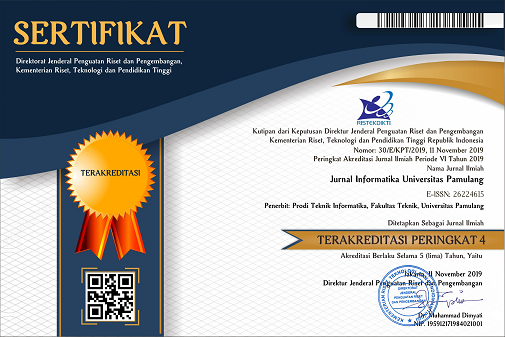Rancang Bangun Komponen Sandbox pada Game Unity dengan Menerapkan Design Patterns dan Arsitektur Microservices
DOI:
https://doi.org/10.32493/informatika.v6i3.10805Keywords:
Unity Game Engine, Sandbox Component, Microservices Architecture, Design PatternsAbstract
Currently the game has covered a very broad market needs where games offer video content, products, Virtual Reality, and special events and game competitions. This offer is what triggers an increase in sales and an increase in revenue in the gaming industry. Due to increasingly fierce competition, game development companies must develop their products quickly and precisely in order to compete in today's game industry. However, rapid product development and the application of proper architecture are also problems, especially the products being developed are games with simulation or sandbox themes that have a high level of complexity. So we need an application that helps game development, especially the development of the sandbox component. The purpose of this study is to provide a library that helps the development of the sandbox component, where this library will apply the Design Patterns and Microservices Architecture to simplify the maintenance and development period of the game after release. This research is also working with the company for the development and validation. This research will develop several sandbox components and will apply a Design Pattern to each component. This proposed method has been tested by users who are experts in developing games. The results show that the application of the proposed method can be implemented and can run well. And the system built also gets a score with an average above 80% and good feedback from expert users. So that this research is expected to become an application that can help programmers later in developing a game application that is good and appropriate. As well as the applications built in this study can also provide recommendations in terms of development methods.References
Ampatzoglou, A., Chatzigeorgiou, A., Charalampidou, S., & Avgeriou, P. (2015). The Effect of GoF Design Patterns on Stability: A Case Study. IEEE Transactions on Software Engineering, 41(8), 781 - 802.
Arthur, L. J. (1985). Measuring Programmer Productivity and Software Quality. New York, United States: John Wiley & Sons, Inc.
Baltezarevic, R., & Baltezarevic, V. N. (2018). The video gaming industry: From play to revenue. International Review Journal, 71-76.
breslin, s. (n.d.). The History and Theory of Sandbox Gameplay. (Gamasutra) Retrieved May 2021, from https://www.gamasutra.com/view/feature/132470/the_history_and_theory_of_sandbox_.php?print=1
Cavano, J. P., & McCall, J. A. (1978). A framework for the measurement of software quality. Proceedings of the software quality assurance workshop on Functional and performance issues, (pp. 133-139).
Herumurti, D., Yunanto, A. A., Senna, G. A., Kuswardayan, I., & Arifiani, S. (2020). Development of First-Person Shooter Game with Survival Maze Based on Virtual Reality. 6th Information Technology International Seminar (ITIS). Surabaya.
Kuswadayan, I., Herumurti, D., Hariadi, R. R., Wildianurahman, M., Yunanto, A. A., & Arifiani, S. (2019). Survival Education for User on Unknown Islands using Simulation Games. 12th International Conference on Information & Communication Technology and System (ICTS). Surabaya, Indonesia.
Maulidan Game. (n.d.). Maulidan Games Profile. Retrieved July 20, 2021, from https://maulidangames.com/
Sutherland, B. (2014). Useful Design Patterns for Game Development. In C++ Game Development Primer (pp. 17-32). Apress, Berkeley, CA.
Vähä, M. (2017). Applying microservice architecture pattern to a design of an MMORPG backend. University of Oulu.
Yunanto, A. A., Herumurti, D., Kuswadayan, I., & Rochimah, S. (2018). Intelligent System for Agent in Educational Game Using Dynamic Gram Similarity. 2018 International Seminar on Application for Technology of Information and Communication. Semarang.
Yunanto, A. A., Herumurti, D., Rochimah, S., & Kuswardayan, I. (2019). English Education Game using Non-Player Character Based on Natural Language Processing. The Fifth Information Systems International Conference. Surabaya, Indonesia.
Downloads
Published
Issue
Section
License
Authors who publish with this journal agree to the following terms:
- Authors retain copyright and grant the journal right of first publication with the work simultaneously licensed under a Creative Commons Attribution-NonCommercial 4.0 International (CC BY-NC 4.0) that allows others to share the work with an acknowledgement of the work's authorship and initial publication in this journal.
- Authors are able to enter into separate, additional contractual arrangements for the non-exclusive distribution of the journal's published version of the work (e.g., post it to an institutional repository or publish it in a book), with an acknowledgement of its initial publication in this journal.
- Authors are permitted and encouraged to post their work online (e.g., in institutional repositories or on their website) prior to and during the submission process, as it can lead to productive exchanges, as well as earlier and greater citation of published work (See The Effect of Open Access).
Jurnal Informatika Universitas Pamulang have CC-BY-NC or an equivalent license as the optimal license for the publication, distribution, use, and reuse of scholarly work.
In developing strategy and setting priorities, Jurnal Informatika Universitas Pamulang recognize that free access is better than priced access, libre access is better than free access, and libre under CC-BY-NC or the equivalent is better than libre under more restrictive open licenses. We should achieve what we can when we can. We should not delay achieving free in order to achieve libre, and we should not stop with free when we can achieve libre.
Jurnal Informatika Universitas Pamulang is licensed under a Creative Commons Attribution-NonCommercial 4.0 International (CC BY-NC 4.0)
YOU ARE FREE TO:
- Share : copy and redistribute the material in any medium or format
- Adapt : remix, transform, and build upon the material for any purpose, even commercially.
- The licensor cannot revoke these freedoms as long as you follow the license terms





